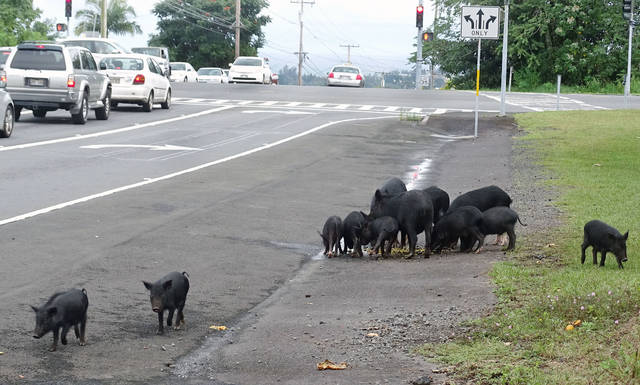HILO — Although feral pig populations on the Big Island appear to remain steady, for some residents, swine incursions seem to be plentiful.
Hunting and trapping seem to be continuing to serve their purpose in maintaining pig numbers at an acceptable level across the island, said Ian Cole, natural area specialist for the Hawaii Island Division of Forestry and Wildlife.
However, Cole said, doing a thorough pig population census is next to impossible, and the nature of wild pigs may make them appear more numerous in certain areas than in others.
“It’s difficult. Homeowners in Puna might tell you pigs are running amok, and at the same time, hunters will say there are no pigs on the mountain,” Cole said.
Cole said that, because of pigs’ constant pursuit of forage and food, they do not stay in one place long enough to obtain an accurate census.
Broadly, however, Cole said that a relative shortage of food in the highlands may have encouraged greater numbers of pigs to seek food closer to populated areas, noting that the Division of Forestry and Wildlife received a spate of calls regarding pigs on private property several weeks ago.
Hawaiian Beaches resident Larry Hovious said his property has attracted the unwanted attention of several pigs recently, with several of the animals tearing apart his lawn in search of earthworms.
“It’s been every other day for the last two or three weeks,” Hovious said. “I’ve lived here for 13, 14 years, and it’s the first time it’s ever really been an issue.”
Hovious said he wasn’t sure whether the pigs had caused problems for his neighbors, but noted that the animals appeared particularly attracted to a specific section of his yard, theorizing that that patch of land is particularly earthworm-rich.
No pig management program has existed in Hawaii County since 2008, when the yearlong Feral Pig Control Pilot Project ended. That program, a state Department of Agriculture project with a budget of $250,000, established a list of vetted hunters who would trap and kill pigs when they were reported on private property so their blood could be taken for disease monitoring.
While that project has ended, the list of hunters from that program remains, and is referred to when residents complain of wild pigs on their property, Cole said.
However, some think that the absence of management programs has made a pig’s ear of the situation.
“There’s too many pigs and not enough hunters to trap them,” said Tom Lodge, chair of Hawaii County’s Game Management Advisory Commission.
Cole acknowledged that hunters are often swamped by calls regarding wild pigs, as many residents seem to report the animals at around the same time.
Meanwhile, Cole said the Division of Forestry and Wildlife had previously lent pig traps to residents, but no longer does so after residents failed to return them.
Lodge said the animals are forced into contact with people more often because they are not able to access less-populated areas in the forest. Fences on state land prevent pigs from entering protected forest areas because they can do significant damage to low-lying plants and seedlings as well as soil-dwelling insects and animals as they root for food.
While Lodge said he has not seen any evidence that pigs damage the forest, Cole said wild pig-related environmental damage is well-documented. The U.S. Department of Agriculture recognizes wild pigs as a destructive invasive species and has a number of programs to control them throughout the country.
Cole said the state’s liberal hunting regulations should continue to sufficiently manage the pig population, although he admitted the animals will be a perennial nuisance to residents.
“Whenever you create a new lot, you’ve just displaced more pigs,” Cole said. “And then you bring in so many hundreds of pounds of soil for a lawn, and they come in and say, ‘Thanks for making this yard for me.’”
Email Michael Brestovansky at mbrestovansky@hawaiitribune-herald.com

